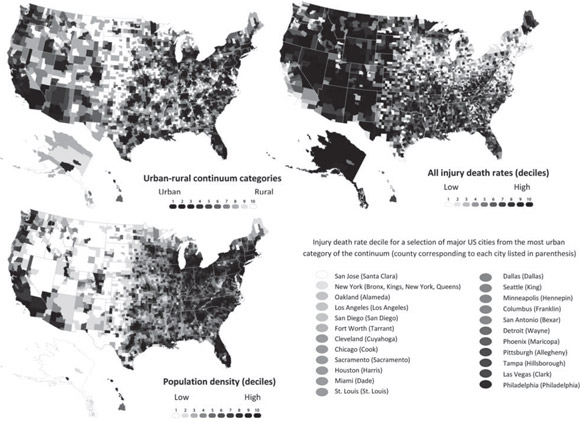City-dwellers considering an escape to the country may not find the rural life so idyllic after all. A study published online today reveals that US rural counties are not as safe as urban ones, with a 22% higher risk of death.
The study, published in the Annals of Emergency Medicine, was conducted by researchers from the American College of Emergency Physicians. They analyzed all 3,141 of the counties in the US during a 7-year period, yielding data on nearly 1.3 million “injury deaths.”
Since many US cities have seen recent reductions in population thanks to perceived crime and safety threats, the researchers wanted to investigate whether these perceptions were based on any truth. The difference in injury risk between urban and rural areas had not been fully studied before.
Alongside the finding that risk of injury death was 22% higher in rural counties than in urban ones, the study also revealed:
- Motor vehicle crashes led to 28 deaths for every 100,000 people in rural areas, versus only 11 deaths per 100,000 in urban areas
- Firearm-related death rates were higher in rural areas for children and people over 45 years of age, but for 22- to 44-year-olds this risk was higher in urban areas.
Lead study author Dr. Sage Myers from the University of Pennsylvania says:
“Cars, guns and drugs are the unholy trinity causing the majority of injury deaths in the US. Although the risk of homicide is higher in big cities, the risk of unintentional injury death is 40% higher in the most rural areas than in the most urban.
And overall, the rate of unintentional injury dwarfs the risk of homicide, with the rate of unintentional injury more than 15 times that of homicide among the entire population.
This has important implications about staffing of emergency departments and trauma care systems in rural areas, which tend to be underserved as it is.”
The study’s authors point to the Department of Health and Human Services’s Healthy People 2020 initiative, which aims to improve access to emergency care in the US. The findings from this study will give a clearer understanding of where services are needed for the initiative.

Higher risk of injury death in rural areas was not the only surprising finding. The study unearthed other unexpected outcomes.
For example, rural areas with the highest levels of college-educated residents and the highest levels of income had a much greater risk of injury death compared with rural counties with the lowest levels of each category.
Additionally, race seems to be a factor in rural counties. Those with large black populations had a much lower risk of death than those with small black communities. And it was the opposite case for rural Latino populations, where large Latino communities had a much higher risk of death than rural locations with small Latino populations.
The researchers call for a greater focus on increased safety risks outside of large cities using population health data.
Dr. Myers notes that the data from the study applies to staffing issues in emergency care, saying: “Injury-related mortality risk is highest in the areas least likely to be covered by emergency physicians and least likely to have access to trauma care, which argues for using a population-planning approach to improve emergency and trauma care systems in the US.”